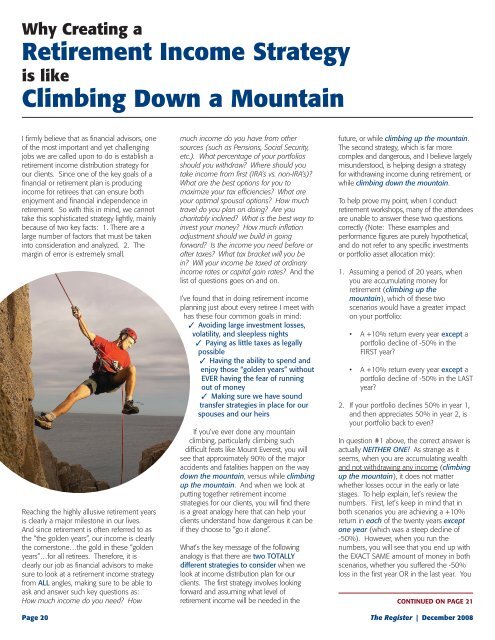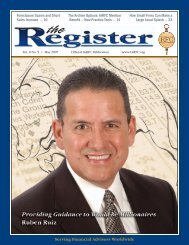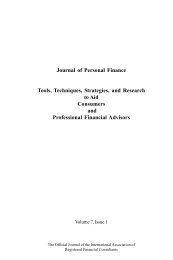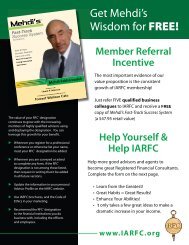Vol. 9 Iss. 12 - iarfc
Vol. 9 Iss. 12 - iarfc
Vol. 9 Iss. 12 - iarfc
You also want an ePaper? Increase the reach of your titles
YUMPU automatically turns print PDFs into web optimized ePapers that Google loves.
Why Creating a<br />
Retirement Income Strategy<br />
is like<br />
Climbing Down a Mountain<br />
I firmly believe that as financial advisors, one<br />
of the most important and yet challenging<br />
jobs we are called upon to do is establish a<br />
retirement income distribution strategy for<br />
our clients. Since one of the key goals of a<br />
financial or retirement plan is producing<br />
income for retirees that can ensure both<br />
enjoyment and financial independence in<br />
retirement. So with this in mind, we cannot<br />
take this sophisticated strategy lightly, mainly<br />
because of two key facts: 1. There are a<br />
large number of factors that must be taken<br />
into consideration and analyzed. 2. The<br />
margin of error is extremely small.<br />
Reaching the highly allusive retirement years<br />
is clearly a major milestone in our lives.<br />
And since retirement is often referred to as<br />
the “the golden years”, our income is clearly<br />
the cornerstone…the gold in these “golden<br />
years”…for all retirees. Therefore, it is<br />
clearly our job as financial advisors to make<br />
sure to look at a retirement income strategy<br />
from ALL angles, making sure to be able to<br />
ask and answer such key questions as:<br />
How much income do you need? How<br />
much income do you have from other<br />
sources (such as Pensions, Social Security,<br />
etc.). What percentage of your portfolios<br />
should you withdraw? Where should you<br />
take income from first (IRA’s vs. non-IRA’s)?<br />
What are the best options for you to<br />
maximize your tax efficiencies? What are<br />
your optimal spousal options? How much<br />
travel do you plan on doing? Are you<br />
charitably inclined? What is the best way to<br />
invest your money? How much inflation<br />
adjustment should we build in going<br />
forward? Is the income you need before or<br />
after taxes? What tax bracket will you be<br />
in? Will your income be taxed at ordinary<br />
income rates or capital gain rates? And the<br />
list of questions goes on and on.<br />
I’ve found that in doing retirement income<br />
planning just about every retiree I meet with<br />
has these four common goals in mind:<br />
Avoiding large investment losses,<br />
volatility, and sleepless nights<br />
Paying as little taxes as legally<br />
possible<br />
Having the ability to spend and<br />
enjoy those “golden years” without<br />
EVER having the fear of running<br />
out of money<br />
Making sure we have sound<br />
transfer strategies in place for our<br />
spouses and our heirs<br />
If you’ve ever done any mountain<br />
climbing, particularly climbing such<br />
difficult feats like Mount Everest, you will<br />
see that approximately 90% of the major<br />
accidents and fatalities happen on the way<br />
down the mountain, versus while climbing<br />
up the mountain. And when we look at<br />
putting together retirement income<br />
strategies for our clients, you will find there<br />
is a great analogy here that can help your<br />
clients understand how dangerous it can be<br />
if they choose to “go it alone”.<br />
What’s the key message of the following<br />
analogy is that there are two TOTALLY<br />
different strategies to consider when we<br />
look at income distribution plan for our<br />
clients. The first strategy involves looking<br />
forward and assuming what level of<br />
retirement income will be needed in the<br />
future, or while climbing up the mountain.<br />
The second strategy, which is far more<br />
complex and dangerous, and I believe largely<br />
misunderstood, is helping design a strategy<br />
for withdrawing income during retirement, or<br />
while climbing down the mountain.<br />
To help prove my point, when I conduct<br />
retirement workshops, many of the attendees<br />
are unable to answer these two questions<br />
correctly (Note: These examples and<br />
performance figures are purely hypothetical,<br />
and do not refer to any specific investments<br />
or portfolio asset allocation mix):<br />
1. Assuming a period of 20 years, when<br />
you are accumulating money for<br />
retirement (climbing up the<br />
mountain), which of these two<br />
scenarios would have a greater impact<br />
on your portfolio:<br />
• A +10% return every year except a<br />
portfolio decline of -50% in the<br />
FIRST year?<br />
• A +10% return every year except a<br />
portfolio decline of -50% in the LAST<br />
year?<br />
2. If your portfolio declines 50% in year 1,<br />
and then appreciates 50% in year 2, is<br />
your portfolio back to even?<br />
In question #1 above, the correct answer is<br />
actually NEITHER ONE! As strange as it<br />
seems, when you are accumulating wealth<br />
and not withdrawing any income (climbing<br />
up the mountain), it does not matter<br />
whether losses occur in the early or late<br />
stages. To help explain, let’s review the<br />
numbers. First, let’s keep in mind that in<br />
both scenarios you are achieving a +10%<br />
return in each of the twenty years except<br />
one year (which was a steep decline of<br />
-50%). However, when you run the<br />
numbers, you will see that you end up with<br />
the EXACT SAME amount of money in both<br />
scenarios, whether you suffered the -50%<br />
loss in the first year OR in the last year. You<br />
CONTINUED ON PAGE 21<br />
Page 20 The Register | December 2008
















